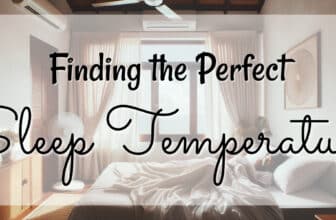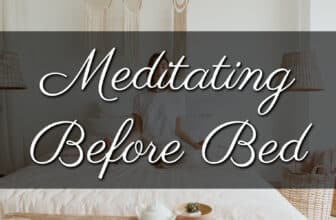There are so many different types of mattresses available on the market today it can be hard to navigate your options. If you find yourself asking, what type of mattress should I get? Look no further! This guide will help you find the best type of mattress. We will arm you with everything you need to make an informed choice that you can be happy with for a long time.
Different types of mattresses: pros and cons
1. Innerspring Mattress
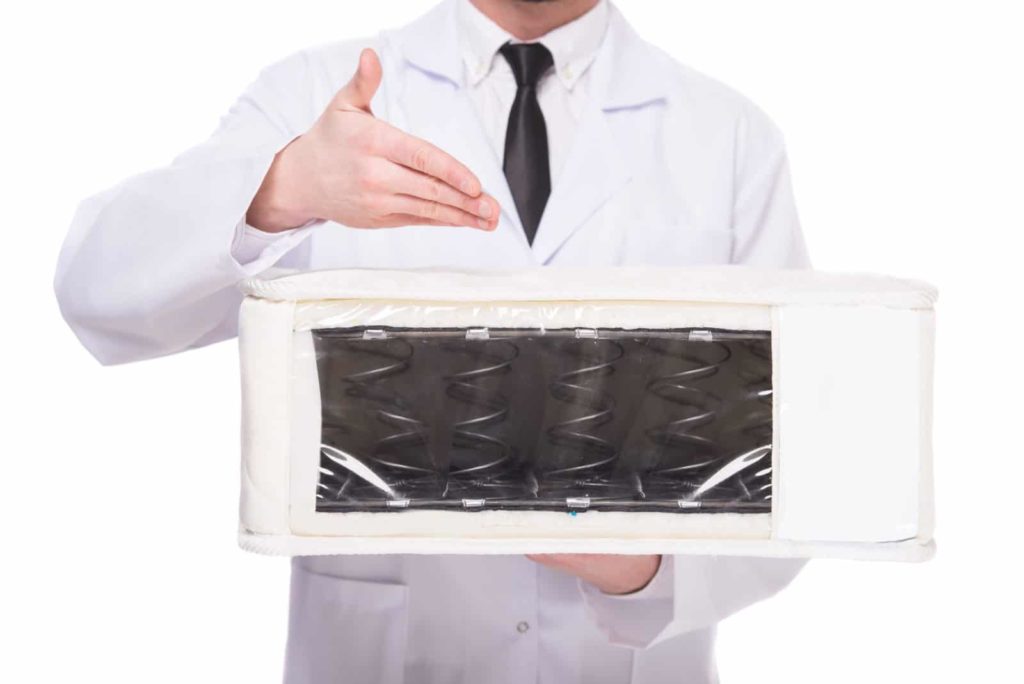
What is an innerspring mattress? The term may seem technical but an innerspring mattress is the kind you are probably most familiar with, depending on your age. They are made out of steel coils designed to compress when you apply weight. The number, their shape, and their size vary from mattress to mattress. As a rule of thumb, the more there are in an innerspring mattress equals more support and higher quality overall.
Innerspring have been around for a long time, since the early 1900s, and most of us best remember using them as kids, even if we no longer use them today in our adult lives. Despite recent advancements in mattress technology, innerspring still remains the most popular type sold on the market today. However, it seems this may be changing.
There are several reasons why the innerspring mattress remains so popular in our current market:
- They are often more affordable.
- They come in a wide variety of firmness options.
- They are available in many convenient locations.
- They are easy to move and usually do not weigh a lot.
- They have a lot of bounce which some people prefer.
Of course, there are some drawbacks as well:
Before buying this type of mattress you should also consider the following information.
- They wear out faster than other, newer types of mattresses. Some begin to sag and wear out in as few as two years. This is bad for spinal health and can lead to a poor quality of sleep.
- Audible squeaking from springs may develop over time which can disturb light sleepers. This may also become a nuisance during intimate moments.
- Owner satisfaction rates are low overall.
- Often cannot be flipped because they are one-sided.
There are several subcategories of an innerspring mattress:
They differ in the mattress construction but are still considered as an innerspring mattress.
Continuous Coils
These use one long wire to form the entire mattress support system. The wire is shaped into an S formation instead of a more traditional coil. These are more durable because of the single wire structure which is repeatedly interlinked. They are relatively affordable compared to some other mattresses as well.
Bonnell Coils
They are the most prevalent and it’s highly likely you have come in contact with them before. They date back as far as the 1800s and were the first type of coil invented. Originally they were made for seat cushions in buggies. They form an hourglass structure that also resembles a helix once fully constructed. Unfortunately, they have been known to be noisy after some wear. However, they should be considered an affordable mid-priced option.
Offset Coils
They are of higher quality and make less noise compared to Bonnell. Aside from pocketed coils, they are the most conforming type of innerspring mattress available. Similar to Bonnell they resemble an hourglass in shape. The difference is in the tops and bottoms of the springs which have flattened edges and are square in shape. They also join to the coil next to them which creates a hinge-like effect allowing the mattress to flex under pressure and conform to your body. These are quiet, supportive, durable, and sturdy, especially considering other innerspring mattresses.
2. Marshall Coil or Pocketed Coil Mattress
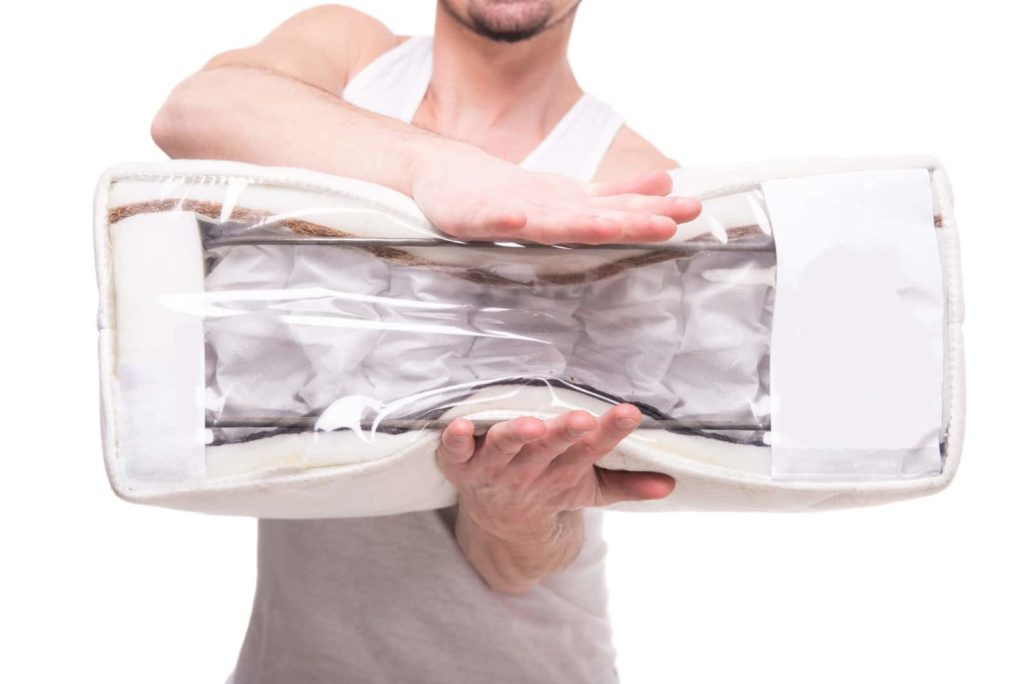
These are also occasionally referred to as wrapped coils or encased coils. Regardless of what we call them, they are very similar to traditional innerspring but their differences deem them worthy of a category specifically for them alone. The two main differences are: the coils are not wired together allowing them to work independent of one another, and they are wrapped separately in fabric pockets or encasements.
Independent, insulated coils allow for improved motion isolation as well as added support. Motion transfer is muted compared to a traditional innerspring mattress because the coils are not connected. This makes them a great option for couples.
When exploring your options, remember that a higher number of coils in the mattress denotes better quality and higher levels of comfort overall. Also, the coil gauge denotes the level of firmness. A thicker coil gauge will produce a firmer mattress which is often more durable. Inversely, a thinner coil gauge will provide a softer mattress.
Is a pocketed coil mattress right for you?
It is not the right option for everyone but you need to consider the following to determine whether or not it is the right option for you specifically:
- They are great for people who prefer a bouncy feeling to their bed.
- They do not provide you with a feeling of sinking in when you lie down. Depending on your preference, this may be a good or a bad trait in your opinion.
- If you value edge support, they excel in this category. The coils are often stronger than some of the specialty foam mattresses we will examine later.
3. Memory Foam Mattress
Memory foam was invented by NASA in 1966. Originally, it was designed as a soft and energy-absorbing material to help improve the safety of cushions in aircraft seats. It took a while to become affordable enough to use in common products but in 1991 the first memory foam mattress hit the market. Now, it can commonly be found in footwear, furniture, bath and kitchen mats, prosthetics, safety helmets, automotive accessories and seats, pillows, and of course mattresses.
Memory foam actively responds to the heat and pressure from your body as you lie down and effectively distributes your weight evenly across the surface to maximize comfort.
These provide you with the sensation of sinking into your bed. It conforms to your body’s shape specifically and allows you to feel enveloped or cradled. The natural contouring slowly reverts once you get out of bed allowing it to go back to its original shape. This means you do not have to sleep in exactly the same spot every night to receive the full contouring effects.
The contouring nature of memory foam makes it an ideal option for people who prefer to sleep on their side. It is also good for people with injuries or chronic pain because it is extra soft.
Memory foam is currently one of the most popular materials used in making mattresses today and it’s predicted to stay that way for a long time to come. They have a fairly high overall customer satisfaction rating.
Some other benefits of memory foam include:
- They encourage healthy spinal alignment.
- They can assist in pain prevention.
- They provide a lot of pressure point relief.
- They have extremely low motion transfer making them ideal for couples and people who sleep with their pets in bed.
- They reduce allergens and dust mites.
- They are versatile enough to fit in adjustable beds and frames.
- They are extremely durable.
Some potential drawbacks to memory foam may include:
- They have higher levels of heat retention than other mattresses because the density of the foam restricts proper airflow causing the temperature to rise. Overnight the heat stays trapped inside causing you to get hotter.
- Poorer quality options may start to form permanent indentations or sag under continued use.
- Less edge support which minimizes the usable surface area of the mattress overall.
4. Gel Mattress
Gels are designed as a way to combat the heat retention found in memory foam. As gel can offset heat retention, it is often infused the foam. This allows you to naturally stay cooler overnight.
Gel does retain some heat but it takes a significant amount of time before this starts to occur. Chances are you will likely be sound asleep by then.
One notable subcategory of a gel mattress involves SomniGel:
SomniGel provides the opposite sensation of a memory foam mattress. Instead of feeling like you are sinking into the material, you will ideally experience the sensation of sleeping or floating on air. This is because SomniGel bounces back from applied pressure rapidly, unlike memory foam.
The sensation of floating is also enabled by its construction which consists of hollow columns allowing maximum airflow. In some mattresses, you will find as little as 22% body contact surface area with as high as 78% open air body contact surface area. This provides superior heat dispersion and easy temperature control making it a great option for people who tend to sleep hotter than normal.
5. Latex Mattress
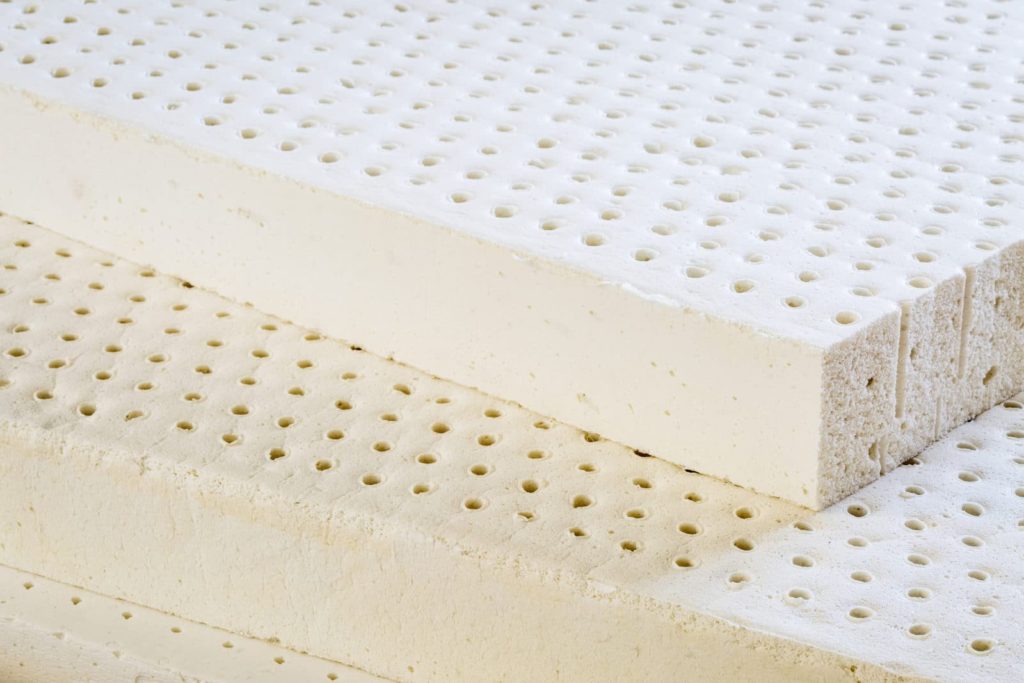
These beds are gaining in popularity due to their high level of durability and overall affordability. Mattresses made with this are similar to memory foam in the way they provide responsive contouring and superior pressure relief. However, they are significantly bouncier than memory foam, they retain less heat than memory foam, and they do not sink in as much when you apply pressure.
It is a natural material when harvested from rubber trees but it can also be a synthetic material that is made in a lab. If you are looking for organic or natural options make sure the material is natural, not synthetic.
There are two different kinds of latex:
They are called Dunlop and Talalay. Two different processes exist for manufacturing latex resulting in the two forms. The different processes denote quality in the final product so it is important to be aware of them.
1. Dunlop latex
The Dunlop process requires the thick sap from the rubber tree to be whipped after extraction. After, it is poured into the mold in one single pour and baked into its final shape. This results in a latex that is softer on top, and denser at the bottom.
2. Talalay latex
The Talalay process adds two additional steps to the Dunlop process. Before the mold is baked, a vacuum is used to suck the air out of the material which produces columns. These columns allow increased breathability and airflow overnight. Then, it is frozen to help stabilize the shape. Talalay has a more consistent feel and sleeps cooler.
Some more benefits of using a latex mattress include:
- They do not use chemicals.
- They do not need to be rotated or flipped.
- They have a minimal smell and off-gassing period.
- They are high quality and can be all natural.
A few drawbacks of a latex mattress include:
- They can often be heavy and difficult to move.
- They are generally pricier than innerspring or coil mattresses.
6. Hybrid Mattress
Hybrids are a great way to get all of the traits that you desire from a mattress. Comfort, support, bounce, and temperature control are all attainable in a bed with a hybrid mattress. These mattresses can be best used on platform beds and are usually preferred by heavy sleepers.
They come in varying combinations of materials and are on track to become the most popular type of mattress due to their advanced adaptability and their high customer satisfaction ratings.
Typically, these consist of a specialized combination of memory foam and coils allowing a highly customized experience.
There are several main differences and options available in the hybrid mattress department:
1. Innerspring latex hybrid mattress
It allows you to have added bounce while maintaining pressure point relief and giving extra support. They are typically more affordable than other primarily latex mattresses.
Incorporating innersprings brings the price down a noticeable amount which is another benefit. Lastly, they are very durable compared to other products in the same price range.
2. Polyfoam latex hybrid mattress
They are ideal for people who sleep on their side for the entire night or majority of the night. They allow you to relieve pressure on the hips and shoulders so you can wake up pain-free.
When considering this type of hybrid mattress, you should look for Talalay specifically instead of Dunlop because you will want the added breathability for temperature control and additional durability.
Take care to consider firmness and softness options when exploring this choice as they often have a wide range.
3. Innerspring memory foam hybrids
These offer several significant benefits. They provide precise support for your entire body, including the places where you need it most. This is enabled by the two materials providing different types of support.
These are often more affordable than solely memory foam ones. They are suitable for people who like to sleep in any position.
7. Pillowtop Mattress
Pillowtops are also occasionally referred to as Euro top mattresses. Exactly like the name sounds, these have a pillow-like layer that forms the top of the mattress and provides an additional layer of padding. They are usually used in conjunction with innerspring, coil, or high-end air mattresses.
The pillowtop can be made from varying materials which offer different benefits such as extra comfort, cooling, durability, and/or added bounce. Some of the materials used for construction are foam, latex, wool, memory foam, or fiberfilm.
Some other benefits gained with a pillowtop mattress include:
- They are easily washed.
- They maintain their shape.
- They allow breathability and often have a cooling effect
- They quickly bounce back
Some drawbacks to a pillowtop mattress are:
- They can be less affordable.
- The pillowtop can produce a slight odor.
- They may be too soft for people who prefer a firmer mattress.
8. Polyfoam Mattress
Polyfoam or polyurethane foam is a synthetic, petroleum-based foam. It is by far the most popular type of foam used in consumer approved mattresses today. Also, it is one of the least expensive materials used in modern mattresses.
Even though polyfoams contain chemicals, rest assured that precautions are taken to ensure that the final product is non-toxic and safe to sleep on continuously.
Always look for the density of the foam because higher density denotes more durability. If a company does not offer the density level of the foam upfront consider this a red flag. Poorer quality products often choose not to mention the density at all so they can avoid disclosing the information if possible.
Some of the main benefits of using a polyfoam mattress include:
- They provide superior support and relief from stiffness and pain.
- They encourage spinal health and realignment while you sleep.
- They can help relieve allergies slightly for some people because they are made from synthetic, inorganic materials.
- They also promote head elevation which can reduce snoring and sleep apnea issues.
9. Organic Mattress or Natural Fiber Mattress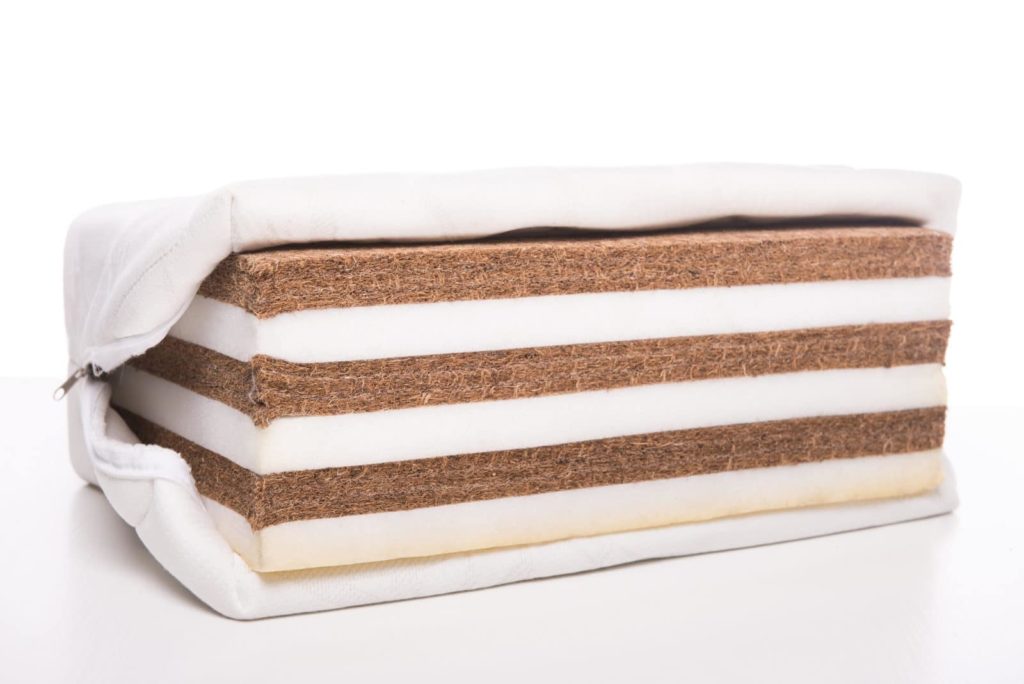
All of the scientific advancements in mattresses has led to little progress in the way of environmental sustainability. With a large focus on this in our global community today, you may be asking yourself what is the best mattress material? Of course, the answer depends on your personal priorities and preferences but some are turning to the organic or natural fiber option for personal health and environmental health reasons.
Organic or natural fiber mattresses are popular for people who want to limit their exposure to chemicals and toxins which can be found in manufactured products like memory foam. Those that are Greenguard gold certified are best known to be the safest and most environmentally friendly available on the market. Looking for this certification will help you start a search that aims for an eco-friendly, chemical free, and toxin free mattress. Natural fiber mattresses are a sure fire way to easily reduce your carbon footprint as well.
Mattresses in this category are constructed with a variety of materials such as natural latex, recycled steel, organic wool, hemp, coconut coir, latex from rubber trees, bamboo, horsetail, organic cotton, support springs, and many more.
It is important to consider the materials used in construction when determining what level of comfort, you will receive from the mattress overall.
Often these cost a bit more than others because the companies advertise most of the products as sustainable, eco-friendly, and non-toxic. Some claim the manufacturing process is more detailed contributing the increased cost as well.
10. Airbeds
Airbeds are not the same thing as a blowup mattress anymore. Now they can be mixed with foam and other materials to provide a superior night’s sleep. These are not as common as the other options offered in this article but should not be dismissed immediately for this reason.
One main benefit is that you do not have to consider sagging overtime as the air can always be refilled. They also allow for a highly customized level of firmness or softness which enables specialized levels of comfort.
The main drawbacks are extended assembly time and the need to often use a loud air pump. These beds are usually used as spares because they are less cumbersome and easier to move.
11. Waterbeds
In the 19th century, waterbeds were originally intended to help patients. Charlie Hall invented and patented the modern version and this started to become popular back in the 1980s. They provide the sensation of floating while you rest on a large rubber mattress size encasement full of water.
Waterbeds are often a hit or miss for people. For some, they can cause lower back pain. For others, they effectively conform to their pressure points alleviating lower back pain.
Newer models have settings that allow you to adjust the firmness of the mattress, the temperature of the mattress, and wave action.
Some drawbacks to a waterbed include:
- They require a difficult and involved setup.
- They require electricity to maintain heat levels. This causes you to continue spending on utility bills throughout the lifetime of its use.
- There is always the possibility that it will puncture or tear causing a leak. Some punctures can be repaired but often it is the end of the mattress.
- They are extremely difficult to move. They must be drained, disassembled, and then reassembled and filled when brought in the new location.
12. Adjustable Mattress and Bed Frame
Adjustable beds look just like regular beds but the frame allows for significant adjustment. Similar to hospital beds, they allow you to elevate your head and/or knees and feet. Some even have a massage option for muscle pain and stress relief.
Some of the main benefits of an adjustable bed include:
- They can alleviate sinus pressure, snoring, and sleep apnea.
- The option for customized elevation can also help reduce back pain experienced from sleep.
- They allow you to sit up in bed comfortably without neck or back strain.
Some potential drawbacks to adjustable beds include:
- They are considerably more expensive than most other options.
- They may need maintenance over time which will cost you more throughout its lifespan.
- They can make a lot of noise.
- They are heavy which makes them difficult to move.
- Some have special sizes making it more difficult to find a variety of bedding that fits properly.
- Some require special tools for cleaning and upkeep because they are mechanical.
The bottom line
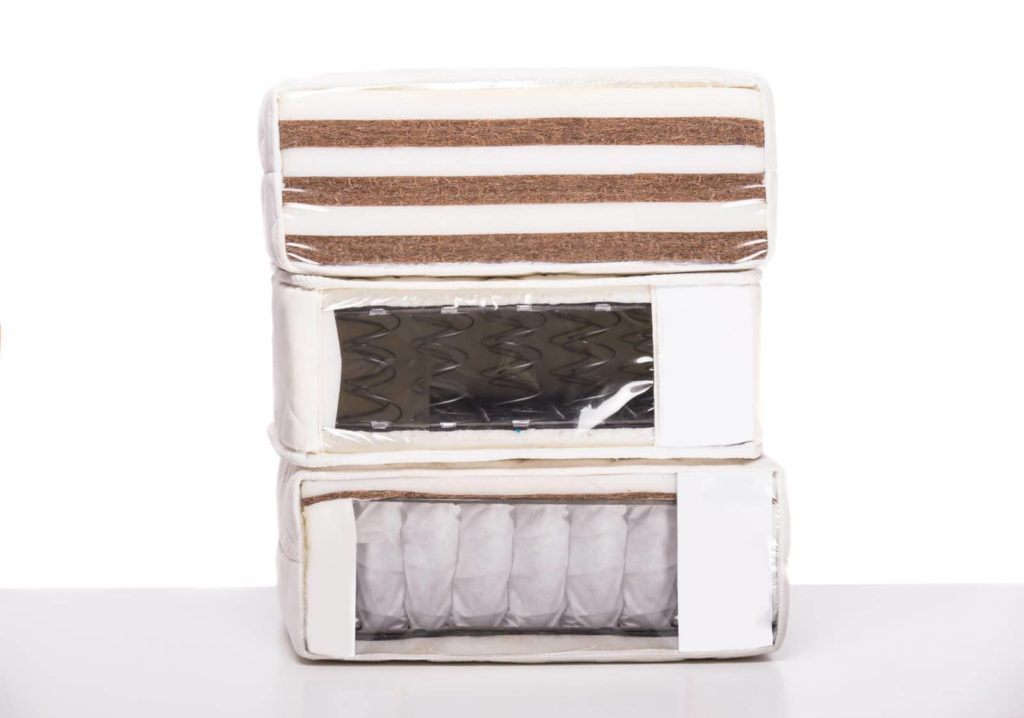
After navigating through this mattress type comparison, you should have a good understanding of the options that are available on the market today. The types of mattresses that suit you depends on your personal sleep preferences. All the mattress differences may seem daunting at first but remember, it is important to do the research before making such a large purchase. It is something that you will rely on for sustained comfort every day, night after night. Hopefully, you no longer need to ask, what kind of mattress do I need? But instead, know what best to look for based on your specific preferences. Good luck with your search!
Additional Resources
- What Is A Platform Bed?
- Latex vs Memory Foam
- How To Make A Mattress Firmer
- Foam vs Spring Mattress
- Types Of Pillows




